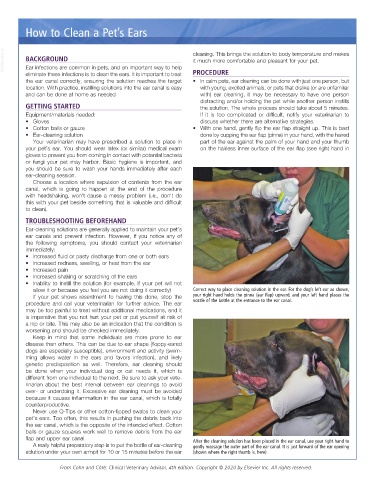Page 3183 - Cote clinical veterinary advisor dogs and cats 4th
P. 3183
How to Clean a Pet’s Ears
VetBooks.ir BACKGROUND cleaning. This brings the solution to body temperature and makes
it much more comfortable and pleasant for your pet.
Ear infections are common in pets, and an important way to help
eliminate these infections is to clean the ears. It is important to treat PROCEDURE
the ear canal correctly, ensuring the solution reaches the target • In calm pets, ear cleaning can be done with just one person, but
location. With practice, instilling solutions into the ear canal is easy with young, excited animals, or pets that dislike (or are unfamiliar
and can be done at home as needed. with) ear cleaning, it may be necessary to have one person
distracting and/or holding the pet while another person instills
GETTING STARTED the solution. The whole process should take about 5 minutes.
Equipment/materials needed: If it is too complicated or difficult, notify your veterinarian to
• Gloves discuss whether there are alternative strategies.
• Cotton balls or gauze • With one hand, gently flip the ear flap straight up. This is best
• Ear-cleaning solution done by cupping the ear flap (pinna) in your hand, with the haired
Your veterinarian may have prescribed a solution to place in part of the ear against the palm of your hand and your thumb
your pet’s ear. You should wear latex (or similar) medical exam on the hairless inner surface of the ear flap (see right hand in
gloves to prevent you from coming in contact with potential bacteria
or fungi your pet may harbor. Basic hygiene is important, and
you should be sure to wash your hands immediately after each
ear-cleaning session.
Choose a location where expulsion of contents from the ear
canal, which is going to happen at the end of the procedure
with headshaking, won’t cause a messy problem (i.e., don’t do
this with your pet beside something that is valuable and difficult
to clean).
TROUBLESHOOTING BEFOREHAND
Ear-cleaning solutions are generally applied to maintain your pet’s
ear canals and prevent infection. However, if you notice any of
the following symptoms, you should contact your veterinarian
immediately:
• Increased fluid or pasty discharge from one or both ears
• Increased redness, swelling, or heat from the ear
• Increased pain
• Increased shaking or scratching of the ears
• Inability to instill the solution (for example, if your pet will not
allow it or because you feel you are not doing it correctly) Correct way to place cleaning solution in the ear. For the dog’s left ear as shown,
If your pet shows resentment to having this done, stop the your right hand holds the pinna (ear flap) upward, and your left hand places the
procedure and call your veterinarian for further advice. The ear nozzle of the bottle at the entrance to the ear canal.
may be too painful to treat without additional medications, and it
is imperative that you not hurt your pet or put yourself at risk of
a nip or bite. This may also be an indication that the condition is
worsening and should be checked immediately.
Keep in mind that some individuals are more prone to ear
disease than others. This can be due to ear shape (floppy-eared
dogs are especially susceptible), environment and activity (swim-
ming allows water in the ears and favors infection), and likely
genetic predisposition as well. Therefore, ear cleaning should
be done when your individual dog or cat needs it, which is
different from one individual to the next. Be sure to ask your vete-
rinarian about the best interval between ear cleanings to avoid
over- or underdoing it. Excessive ear cleaning must be avoided
because it causes inflammation in the ear canal, which is totally
counterproductive.
Never use Q-Tips or other cotton-tipped swabs to clean your
pet’s ears. Too often, this results in pushing the debris back into
the ear canal, which is the opposite of the intended effect. Cotton
balls or gauze squares work well to remove debris from the ear
flap and upper ear canal.
A really helpful preparatory step is to put the bottle of ear-cleaning After the cleaning solution has been placed in the ear canal, use your right hand to
gently massage the outer part of the ear canal. It is just forward of the ear opening
solution under your own armpit for 10 or 15 minutes before the ear (shown where the right thumb is, here).
From Cohn and Côté: Clinical Veterinary Advisor, 4th edition. Copyright © 2020 by Elsevier Inc. All rights reserved.

